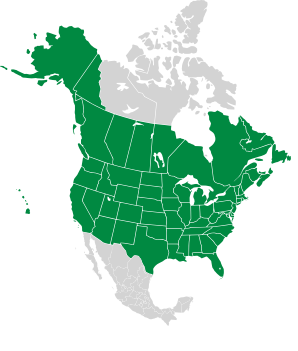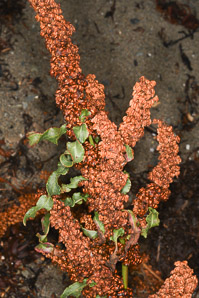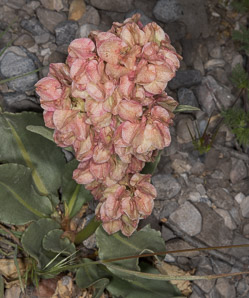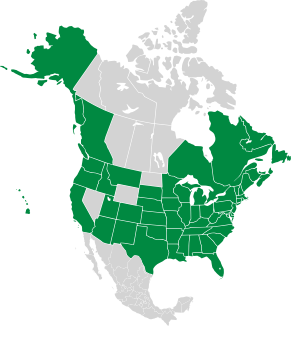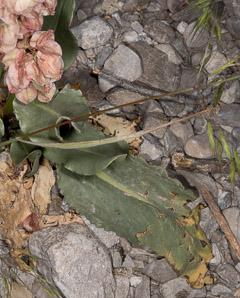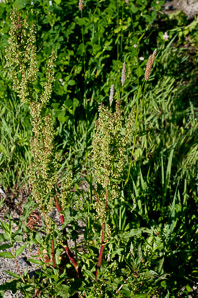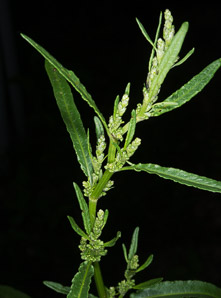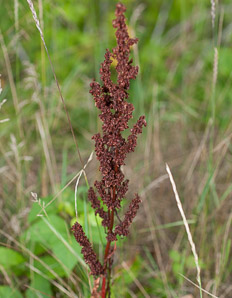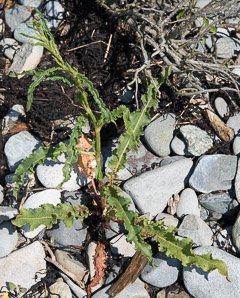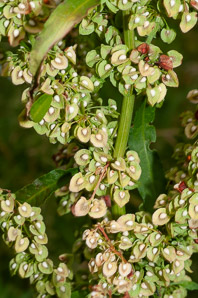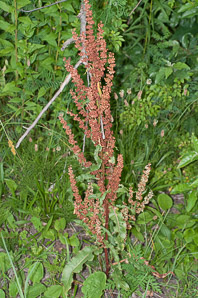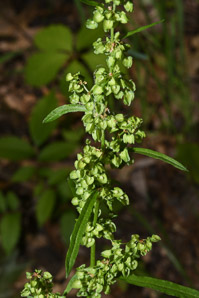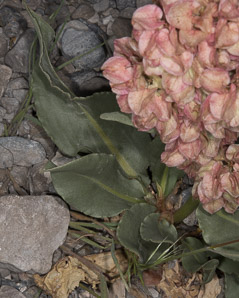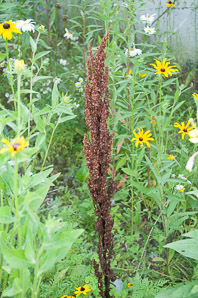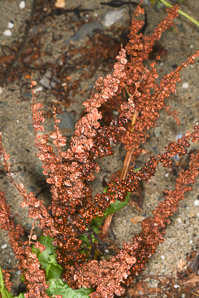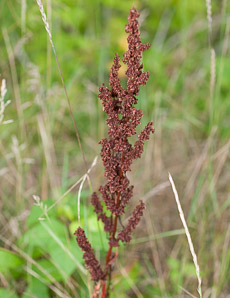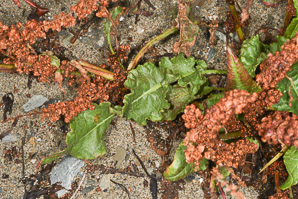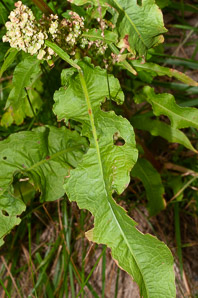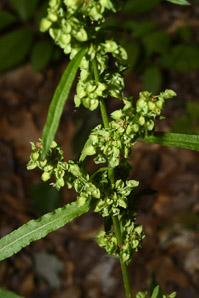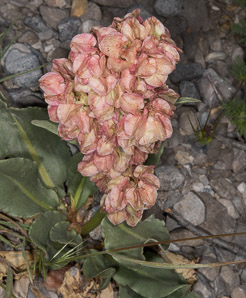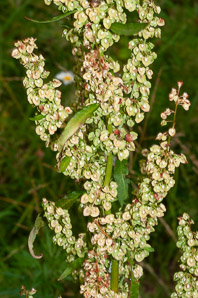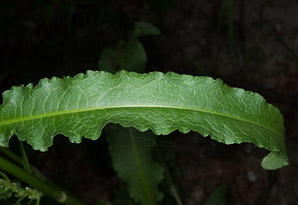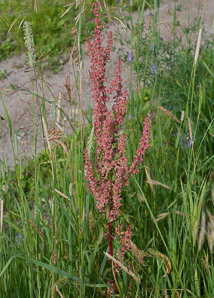
|
Rumex crispus L. Curly dock, wild rhubarb
This species is native to Europe and western Asia, now widespread throughout North America and most of the rest of the planet as well. It is common in disturbed habitats, railroad beds, fallow fields, ocean beaches, and other wetland margins. Plants: Plants are 12-55″ (30-140 cm) in height, erect but with a few branches. Leaves: A large basal rosette about 1′ (30 cm) around consists of smooth-edged, distinctively wavy (“crisped”) alternate leaves. Each leaf is up to 6″ (15 cm) × 1″ (2.5 cm), oblong-lanceolate in shape, and hairless. Fruit—the upper portion of the plants—and stems become dark brown as the plant ages. Flowers: A panicle of racemes of whorls of flowers appears at the upper 6-18″ (15-45 cm). (In other words, there are a whole pile of tiny, greenish, weird-looking flowers.) Each yellowish or reddish green flower is about ⅛″ (3.2 mm) long. If you look closely, it consists of 3 inner sepals, 3 outer sepals, 3 styles, and an ovary. Fruits: Each flower becomes a heart-shaped, toothless fruit 1/16-⅛″ (2-4 mm) that contains a single white seed. The seeds become dark brown, and can persist in the soil for up to 50 years. These are closely similar: |
Found a few feet from high tide, this could be the subspecies uglinosa or littoreus · 9/18/2016 · Deer Isle Beach Vegetation Recla 4/29/2018 · Willow Spring Picnic Area, Red Rock Canyon, Nevada · ≈ 5 × 8″ (13 × 20 cm) |
||||||||||||||||||||||||||||
|
| |||||||||||||||||||||||||||||
| You are here Rumex crispus |
Rumex obtusifolius |
||||||||||||||||||||||||||||
|---|---|---|---|---|---|---|---|---|---|---|---|---|---|---|---|---|---|---|---|---|---|---|---|---|---|---|---|---|---|
| Common Name |  |
 |
|||||||||||||||||||||||||||
| Plant | 12-55″ (30-140 cm) in height, erect but with a few branches. | 1-4′ (30-121 cm), on stout stems that don’t branch except just below the flowerheads. | |||||||||||||||||||||||||||
| Flowers | A panicle of racemes of whorls of flowers appears at the upper 6-18″ (15-45 cm). (In other words, there are a whole pile of tiny, greenish, weird-looking flowers.) Each yellowish or reddish green flower is about ⅛″ (3.2 mm) long. If you look closely, it consists of 3 inner sepals, 3 outer sepals, 3 styles, and an ovary. | On spike-like racemes, greenish, pinkish, or reddish. They appear from June to October. | |||||||||||||||||||||||||||
| Leaves | A large basal rosette about 1′ (30 cm) around consists of smooth-edged, distinctively wavy (“crisped”) alternate leaves. Each leaf is up to 6″ (15 cm) × 1″ (2.5 cm), oblong-lanceolate in shape, and hairless. | Basal leaves are not arranged in a rosette, and are oval, oblong, or heart-shaped, usually red-veined.. Upper leaves are lanceolate. All leaves have wavy edges, but less so than with curly dock. | |||||||||||||||||||||||||||
| Fruit | Each flower becomes a heart-shaped, toothless fruit 1/16-⅛″ (2-4 mm) that contains a single white seed that matures to dark brown. | ~1/16″ (2-2.7 mm), comprised of triangular “valves" (wings), each with 2-4 spiny teeth on margins. One of the three wings has a seed. | |||||||||||||||||||||||||||
| Range/ Zones |
|
|
|||||||||||||||||||||||||||
| Habitats | Disturbed habitats, railroad beds, fallow fields, ocean beaches, and other wetland margins. | Ditches, roadsides, wetlands, meadows, riparian areas, alfalfa and pasture fields (especially with poor drainage), orchards and other disturbed moist areas. | |||||||||||||||||||||||||||
| Type | Wild | Wild | |||||||||||||||||||||||||||
| Occurrence | Common | Common | |||||||||||||||||||||||||||
Edibility: Stems and leaves are sometimes consumed with salad. Fairly high levels of oxalic acid make this plant mildly poisonous, and make regular consumption dangerous to people with a variety of pre-existing medical conditions. One death, from a soup made from the leaves, has been described.
Medical: No proven properties. Said to be laxative and mildly tonic.
Online References:
References:
Clemants, Steven; Gracie, Carol, Wildflowers in the Field and Forest, Oxford University Press, 2006, p. 232
Multiple Authors, PDR for Herbal Medicines, Thomson Healthcare Inc., 2007, p. 919
4/29/2018 · Willow Spring Picnic Area, Red Rock Canyon, Nevada · ≈ 6 × 10″ (16 × 24 cm) 
5/25/2010 · Nashua River Rail Trail, Ayer, Massachusetts · ≈ 1 × 1½′ (34 × 52 cm) 
6/2/2014 · Big Bear Mountain, Brookline, Massachusetts · ≈ 6 × 8″ (14 × 20 cm) 
8/4/2010 · Nashua River Rail Trail, Groton Center, Groton, Massachusetts · ≈ 10 × 15″ (26 × 39 cm) 
6/16/2013 · Birch Point State Park, Owl’s Head, Maine · ≈ 1½ × 2½′ (53 × 79 cm) 
7/7/2012 · Gibbet Hill, Groton, Massachusetts · ≈ 3½ × 5″ (9.2 × 13 cm) 
6/22/2010 · Nashua River Rail Trail, Ayer, Massachusetts ![]() ID is dubious
ID is dubious 
6/13/2016 · Nashua River Rail Trail, Groton, Groton, Massachusetts 
4/29/2018 · Willow Spring Picnic Area, Red Rock Canyon, Nevada · ≈ 6 × 10″ (16 × 24 cm) 
Rumex crispus description by Thomas H. Kent, last updated 18 Jul 2020.
© FloraFinder.org. All rights reserved.
8/1/2009 · Gordon & Kathy’s, Prospect, Maine · ≈ 1½ × 2½′ (56 × 84 cm) 
Found a few feet from high tide, this could be the subspecies uglinosa or littoreus · 9/18/2016 · Deer Isle Beach Vegetation Recla 
8/4/2010 · Nashua River Rail Trail, Groton Center, Groton, Massachusetts · ≈ 10 × 15″ (26 × 39 cm) 
Found a few feet from high tide, this could be the subspecies uglinosa or littoreus · 9/18/2016 · Deer Isle Beach Vegetation Recla 
7/7/2012 · Gibbet Hill, Groton, Massachusetts · ≈ 7 × 11″ (18 × 27 cm) 
6/13/2016 · Nashua River Rail Trail, Groton, Groton, Massachusetts 
4/29/2018 · Willow Spring Picnic Area, Red Rock Canyon, Nevada · ≈ 5 × 8″ (13 × 20 cm) 
7/7/2012 · Gibbet Hill, Groton, Massachusetts · ≈ 6 × 9″ (14 × 22 cm) 
6/2/2014 · Big Bear Mountain, Brookline, Massachusetts · ≈ 9 × 6″ (23 × 16 cm) 
6/22/2010 · Nashua River Rail Trail, Ayer, Massachusetts · ≈ 1 × 2′ (41 × 62 cm) ![]() ID is dubious
ID is dubious 
Range:
